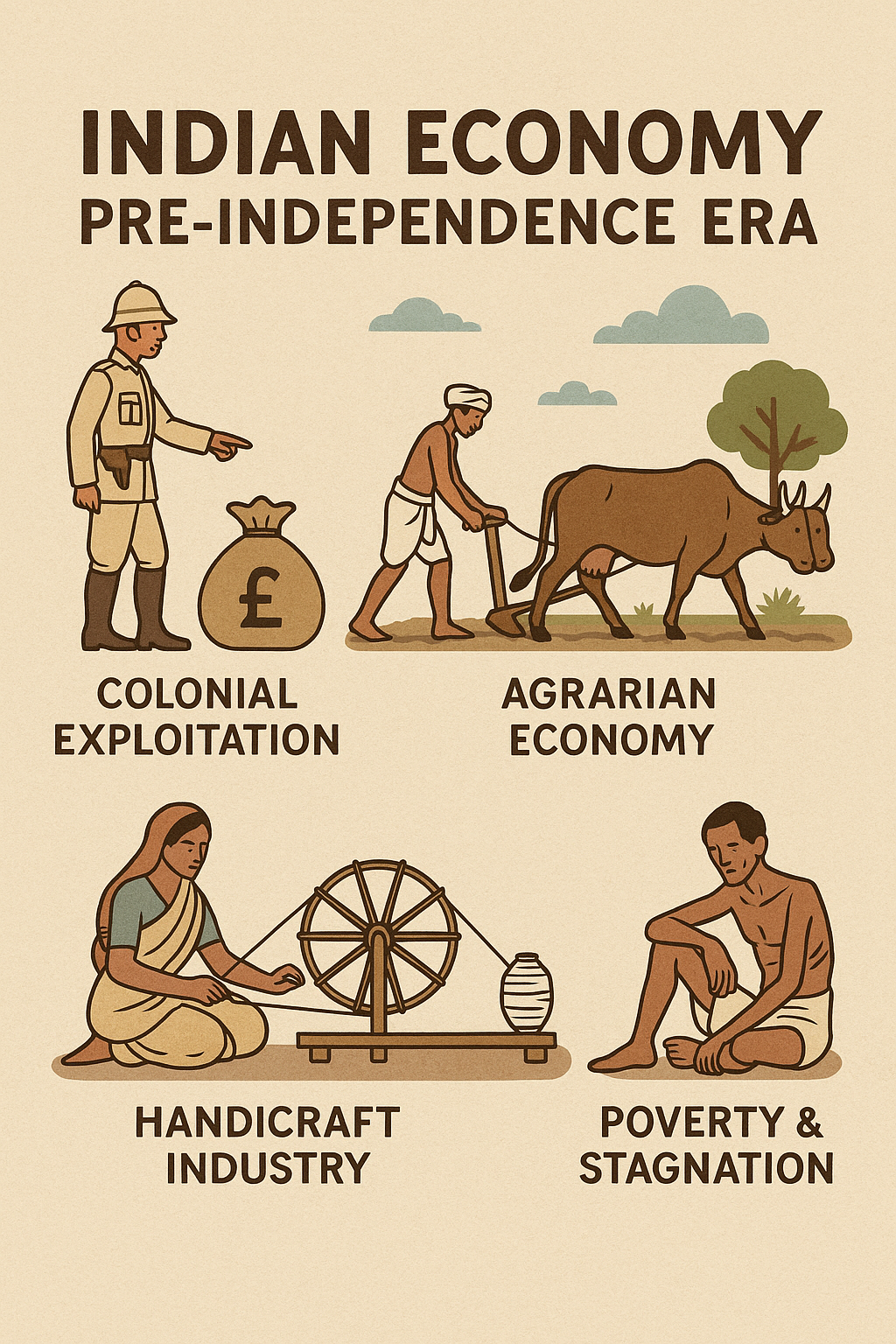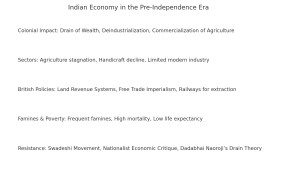
27 Jul Indian Economy Pre-Independence Era
Indian Economy in the Pre-Independence Era – UPSC Economics Optional Paper 2
The pre-independence era of Indian economic history provides critical insights into the structural distortions, economic exploitation, and colonial legacy that shaped post-independence economic policies. This topic is a key component of Paper 2 of the UPSC Economics Optional syllabus and includes British colonial policies, the agrarian structure, industrial decline, and the nationalist critique of colonial rule.
📊 Infographic – Indian Economy in the Pre-Independence Era

indian economy pre independence era
🧠 Mind Map – Structure of Pre-Independence Indian Economy
1. Overview of the Indian Economy Before 1947
The Indian economy before independence was primarily agrarian, stagnant, and underdeveloped. It was marked by colonial exploitation, deindustrialization, heavy dependence on agriculture, and lack of indigenous capital formation. British policies fundamentally altered the structure of the Indian economy to serve colonial interests.
2. British Colonial Economic Policies
2.1 Drain of Wealth
The Drain Theory articulated by Dadabhai Naoroji highlighted how Britain extracted economic surplus from India without any returns. Public revenue, trade surpluses, and resources were siphoned off to finance British needs.
2.2 Free Trade Imperialism
After 1813, India was opened up to British goods, leading to the decline of domestic industries. The British forced a free trade regime on India while maintaining protectionism at home.
2.3 Land Revenue Systems
- Zamindari System (Permanent Settlement): Introduced in Bengal by Cornwallis in 1793. Created a class of absentee landlords.
- Ryotwari System: Introduced in Bombay and Madras. Direct settlement with cultivators.
- Mahalwari System: Group settlements in north-west India.
All systems led to high taxation, insecurity, and indebtedness of peasants.
3. Agricultural Backwardness
- Low productivity due to lack of investment, poor irrigation, and traditional tools
- Subsistence farming and vulnerability to natural calamities
- Commercialization without adequate market development
- Frequent famines due to export-oriented policies and neglect of food security
4. Industrial Decline and Deindustrialization
4.1 Decline of Handicrafts
Artisan industries such as textiles, metal work, and pottery were severely impacted by competition from machine-made British goods. Loss of patronage and markets led to large-scale unemployment among artisans.
4.2 Stunted Industrialization
- Modern industries like cotton textiles, jute, and iron began in the late 19th century
- Industrial development was limited and confined to a few regions (Bombay, Calcutta)
- Lack of capital, infrastructure, and state support hindered industrialization
-
GS paper 4 syllabus and study plan
GS paper 3 syllabus and study plan
5. Infrastructure Development with Extractive Intent
5.1 Railways
While railways expanded trade, they were primarily built to transport raw materials from interior to ports. They facilitated British exports but did not integrate Indian markets.
5.2 Ports and Roads
Ports were developed to serve colonial trade. Roads remained underdeveloped in rural India, further isolating villages.
5.3 Irrigation
Irrigation projects like canals were started but were concentrated in a few provinces and driven more by revenue interests than agricultural development.
6. Foreign Trade under Colonial Rule
- India exported raw materials (cotton, indigo, opium) and imported British manufactures
- India ran a large trade surplus, but the earnings were used to pay “Home Charges”
- Colonial trade structure led to lack of diversification and vulnerability to global price fluctuations
7. Demographic and Social Indicators
- High birth and death rates
- Life expectancy below 30 years
- High infant mortality rate
- Low literacy and absence of public health infrastructure
8. Nationalist Critique of British Economic Policy
8.1 Dadabhai Naoroji
First Indian to use economic statistics to highlight the economic exploitation by British rule. His famous work “Poverty and Un-British Rule in India” outlines the drain of wealth.
8.2 R.C. Dutt
Criticized land revenue policies and their role in causing famines. His “Economic History of India” remains a classic account of colonial exploitation.
8.3 Gopal Krishna Gokhale
Focused on the need for public expenditure on education and welfare and criticized unjust taxation policies.
9. Rise of Swadeshi Movement
The partition of Bengal in 1905 triggered a nationwide call for self-reliance in goods and services. The Swadeshi movement was both a political and economic movement aimed at industrial regeneration.
10. Economic Impact of World Wars
- WWI increased demand for Indian goods, but prices soared due to supply shortages
- WWII led to the growth of wartime industries but inflation and scarcity worsened poverty
- Post-war years witnessed unemployment and stagnation
11. Legacy of Colonial Rule
- Highly unequal land ownership and rural indebtedness
- Poor infrastructure outside of extractive needs
- Limited industrial base and skilled labor
- Weak capital markets and lack of entrepreneurship
- Deep socio-economic divisions and mass poverty
📚 Previous Year UPSC Questions (PYQs)
- Critically examine the economic impact of British rule on Indian agriculture. (2021)
- Explain the concept of Drain of Wealth. How did it affect India’s development? (2019)
- Discuss the process of deindustrialization during colonial rule. (2018)
🔮 Probable Questions for Upcoming UPSC Prelims & Mains
- Discuss the objectives and outcomes of land revenue systems introduced by the British.
- Evaluate the role of the Swadeshi Movement in shaping India’s economic nationalism.
- How did British trade policies contribute to India’s underdevelopment?
- Compare the views of Naoroji and R.C. Dutt on the economic critique of colonialism.




No Comments